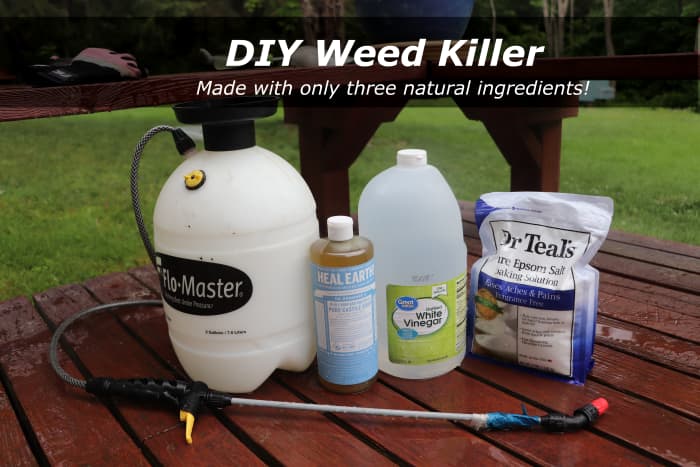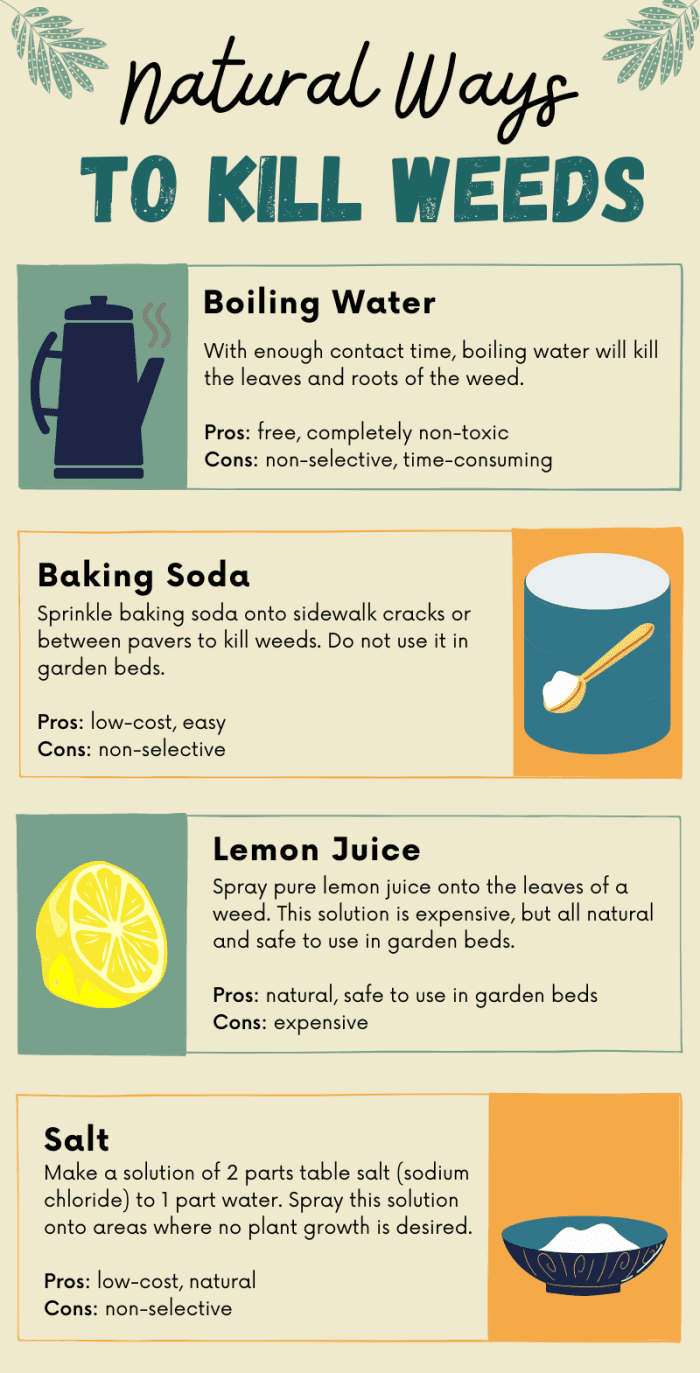How to Get Rid of Cicada Killer Wasps Naturally
After working as a chemist at a biotechnology company, I enjoy writing about science, travel, and gardening.

Three natural ingredients create a pet-safe weed killer that will not harm wildlife.
Leah Lefler, 2021
Keeping my garden weed-free using non-toxic and all-natural ingredients is important to my family. We want to keep our pets safe and prevent harm to wildlife, including frogs and fireflies living in our yard.
How to Make Homemade Weed Killer (Easy, All Natural, and Cheap!)
The fastest-acting weed killer is made with a simple solution of vinegar, Epsom salt, and castile soap. This solution works by dehydrating the plant's leaves with the Epsom salt and vinegar and works best on a sunny, dry day. The soap acts as a surfactant to help the salt and vinegar solution stick to the leaves of the weeds. This weed killer does not kill the root of the weed, however, and must be reapplied when new growth appears.
In this formula, Epsom salt (magnesium sulfate) is used instead of table salt (sodium chloride) to prevent the build-up of toxic levels of sodium in the soil. In addition, castile soap is used instead of synthetic dishwashing liquid. Castile soap is made from vegetable oil and is organic and biodegradable.
Materials
- 1 gallon (3.8 liters) white vinegar
- 2 cups Epsom salt (magnesium sulfate)
- ¼ cup castile soap, such as Dr. Bronner's
Instructions
- Add the vinegar to a large garden sprayer.
- Add the Epsom salt to the sprayer.
- Add the castile soap, and gently swirl to mix the ingredients. Do not shake the solution, as this will cause the soap to foam.
- Replace the lid on the garden sprayer and use in the desired areas.

Within hours, the homemade spray destroys the foliage on weeds.
Leah Lefler, 2021
Use This Spray Sparingly
Be aware that this weed killer is non-specific and will kill the leaves of any plant it comes in contact with. Take care to avoid overspray onto flowers and garden plants. In addition, repeated use of this spray will lead to a build-up of magnesium sulfate in the garden. Plants find small amounts of magnesium useful for growth, but an excess of magnesium will inhibit desired garden plants from using phosphorus required for growth.
In short, it is not a good idea to use repeated applications of DIY weed killer in a vegetable garden or flower garden. Reserve this spray for sidewalk cracks and garden paths you wish to keep clear of weeds.

Make small batches of weed killer in a spray bottle to use in small areas.
Leah Lefler, 2021
Small Batches of Weed Killer
One gallon of DIY Weed Killer will cover approximately 1,000 square feet of garden space. For smaller areas, it is easy to scale down the recipe.
| Quantity Desired | ½ Gallon | 4 Cups | 2 Cups | 1 Cup |
|---|---|---|---|---|
| Vinegar | 7 cups | 3 ½ cups | 1 ¾ cups | 1 cup |
| Epsom Salt | 1 cup | ½ cup | 3 ½ Tablespoons | 2 Tablespoons |
| Castile Soap | 2 Tablespoons | 1 Tablespoon | ½ Tablespoon | ¾ teaspoon |
| Coverage | 500 square feet | 250 square feet | 125 square feet | 62.5 square feet |

If you don't have castile soap or Epsom salt on hand, these weed-killing methods only require single ingredients that you likely already have in your kitchen.
Canva
Other Natural Weed Killers
Several alternatives are available for controlling weed growth, including:
- Boiling water: Pour boiling water over weeds. With enough contact time, the boiling water will kill the leaves and roots of the weed. This method is almost free of cost and is the least likely to cause damage to the ecosystem. This method is also safe for use in raised bed gardens, if you take care to prevent the boiling water from coming in contact with desired plants.
- Baking soda: Sprinkle baking soda onto sidewalk cracks or between pavers to kill weeds. Do not use it in garden beds.
- Lemon juice: Spray pure lemon juice onto the leaves of a weed. This solution is expensive, but all natural and safe to use in garden beds.
- Salt: Make a solution of 2 parts table salt (sodium chloride) to 1 part water. Spray this solution onto areas where no plant growth is desired.
Non-Natural Homemade Weed Killers
Other household items, including bleach and rubbing alcohol, may be used as weed killers. While these methods work as effective defoliants, they will infiltrate the soil under the weeds and may infiltrate groundwater supplies.
Bleach is toxic to wildlife and is not recommended for use in your garden. Likewise, rubbing alcohol is toxic to animals and might be ingested by your pets (or absorbed through the skin).
Read More From Dengarden
Borax Should Not be Used as a Weed Killer
While Borax (sodium borate) is an all-natural mineral, it is not recommended for use in your yard or garden. It is alkaline and a skin irritant. In high doses, it is toxic and should not be consumed by pets, children, or other wildlife.
Its mechanism of action is through the dehydrating effect of sodium—table salt will work as well as Borax for this effect without risking skin irritation.

Boiling water is a completely non-toxic way to kill weeds in the garden. Use a tea kettle as an easy way to control the direction of boiling water in your garden. This will keep your plants safe while eliminating the targeted weed.
Leah Lefler, 2021

Leah Lefler, 2021
How to Get Rid of Weeds Without Killing Plants
As all homemade solutions are non-selective, it is important to protect other plants from overspray. A simple way to do this is to cut out the bottom of a plastic cup, placing it around the targeted weed. Spray the solution onto the weed's leaves, avoiding the soil. The sides of the plastic cup will prevent overspray from getting onto nearby garden plants.
When using boiling water, a heat-proof container with a narrow spout will allow the boiling water to be directed to the targeted weed.

Protect surrounding plants from non-specific weed-killing spray by using a plastic cup with the bottom cut out as a barrier.
Leah Lefler, 2021
Pros and Cons of DIY Weed Killer
A comparison of homemade weed-killing solutions to common commercial herbicides shows the environmental benefits of using an all-natural solution.
| Weed Killer | Efficacy | Toxicity | Selectivity | Cost |
|---|---|---|---|---|
| Vinegar/Epsom Salt/Soap Solution | Kills leaves only | May cause build-up of magnesium in the soil over time. | Non-selective | Inexpensive |
| Boiling Water | Kills roots and leaves | None | Non-selective | Inexpensive |
| Lemon Juice | Kills leaves only | None | Non-selective | Expensive for large quantities |
| Baking Soda | Kills leaves only | May cause build-up of sodium in the soil over time. | Non-selective | Inexpensive |
| RoundupⓇ (glyphosate) | Kills roots and leaves | Toxic to amphibians | Selective (does not kill grass) | Expensive |
| Gordon's Amine 400 (2, 4-D) | Kills roots and leaves | Kills earthworms | Selective (does not kill grass) | Moderately expensive |
Glyphosate, the active ingredient in RoundupⓇ, is highly toxic to frogs and tadpoles, along with other amphibians (King and Wagner 318-324). Another common commercial herbicide is called 2, 4-D (2,4-Dichlorophenoxyacetic acid). This chemical is toxic to earthworms, a common food of firefly larvae.
Prevent Weeds From Growing With Natural Barriers
Stopping weeds from growing where they are not wanted is less taxing than repeatedly spraying or pulling weeds established in your yard. There are many pre-emergent weed control techniques that will save a lot of future labor, including:
- Apply a thick layer of mulch. Mulch flower beds with bark, 3–4 inches deep. This prevents sunlight from reaching germinating weed seeds, stopping growth from occurring.
- Use newspaper as a natural weed cloth. Use at least 10 pages of thickness under mulch or a stone pathway. This stops sunlight from reaching the leaves of young weeds.
- Let your lawn grow a little taller. Cutting grass too short allows weed seeds access to the soil, infiltrating your lawn. Taller grass helps prevent weeds from gaining traction in your yard.
- Use thick ground cover. Ice Plant, Creeping Jenny, Stonecrop, Thyme, and Cranesbill are among the best ground covers to prevent weed growth.
- Apply corn gluten. Corn gluten is useful for preventing weed growth. This natural byproduct of the corn milling process dehydrates young seedlings and prevents root formation. It must be applied, watered into the ground, and then remain dry for approximately three days to function as a good preventive measure. Do not apply if it is likely to rain within three days of application.
This content is accurate and true to the best of the author's knowledge and is not meant to substitute for formal and individualized advice from a qualified professional.
© 2021 Leah Lefler
Leah Lefler (author) from Western New York on June 10, 2021:
Thank you, Devika. We try to use natural and homemade items where we can! It is much better for the environment, and for us!
Devika Primić from Dubrovnik, Croatia on June 10, 2021:
A useful hub and it is a great idea with home remedies.
Leah Lefler (author) from Western New York on June 10, 2021:
I often spend a lot of time pulling stubborn weeds, Adrienne, particularly in my vegetable garden. Mulch helps keep the weeds down, but thistles are a particular problem where I live. We have chickens, a cat, and a dog in addition to children and toxic chemicals are not an option for our family. We love seeing all of the frogs and fireflies in our yard and wouldn't want to harm them!
Leah Lefler (author) from Western New York on June 10, 2021:
We try to take care of our yard in a responsible way, Peggy. We are one of the few yards in our neighborhood with fireflies because we don't use toxic pesticides or herbicides in our yard.
Leah Lefler (author) from Western New York on June 10, 2021:
It works extremely well for weeds growing in pavement cracks, Glenn! I applied it to our sidewalk a few days ago and the weeds are completely withered. While they might come back from the root, the spray is so simple to make and easy to use that it is no bother to repeat the process!
Adrienne Farricelli on June 10, 2021:
Thanks for sharing this Leah. There are always unsightly weeds around my area and I always pulled them out, and of course they grow back so fast. I am in no way ever going to use the toxic weed killers.
Peggy Woods from Houston, Texas on June 09, 2021:
I like the idea of using natural ingredients that do not harm other creatures. Thanks for this list of items to use.
Glenn Stok from Long Island, NY on June 09, 2021:
Your article is very timely, Leah, because I'm having a weed problem this year. They are growing through cracks in my driveway.
Interestingly, you mentioned that this is a safe location to apply the weed killer since it's away from other vegetation that I wouldn't want to hurt.
Since I'm always concerned about adding toxic chemicals to the environment, I'd rather try your formula. I'll do it this week. Thanks for the idea.
How to Get Rid of Cicada Killer Wasps Naturally
Source: https://dengarden.com/gardening/How-to-Get-Rid-of-Weeds-Naturally-With-Homemade-Weed-Killer

0 Response to "How to Get Rid of Cicada Killer Wasps Naturally"
Post a Comment